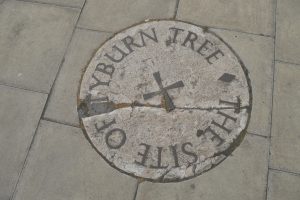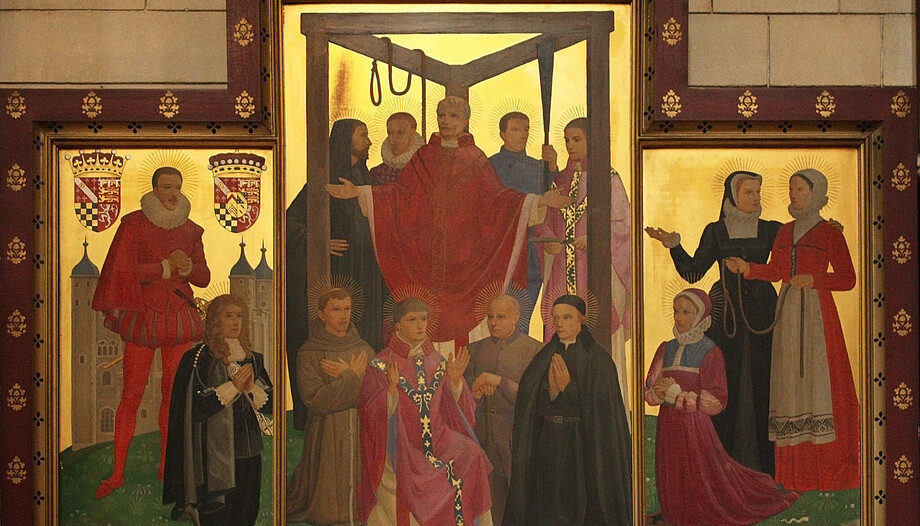The story of "the forty martyrs of England and Wales", both lay and religious, canonized by Paul VI on October 25, 1970, is framed within the religious persecution that took place in England during the 16th century, after Henry VIII separated from the Catholic Church in 1534 in order to divorce his wife, Catherine of Aragon, and marry Anne Boleyn.
Some of them were executed on December 1.
St. Alexander Briant
St. Alexander Briant was born in Somerset, England, in 1556. He converted to Catholicism while studying at Oxford University. Later, in 1577, he left his native country to continue his studies in Douai, France. In this city a university had recently been founded to train "recusant" priests (those who refused to adopt the state religion of England, Anglicanism), because Queen Elizabeth I had established harsh penal laws against Catholics.
Father Briant was ordained a priest in Cambrai (France) in 1578. Shortly thereafter, in 1579, he returned to England, where he served as a Catholic priest alongside Father Persons. Persons was one of the priests most wanted by the government and it was precisely while trying to capture him that Briant was found by chance and arrested. Two weeks later, he was transferred to the Tower of London, where he was cruelly tortured.
He was then transferred to a cell called "The Pit", where he was locked up in complete darkness for 8 days. He was subjected to other tortures, such as the rack: in addition to considering his writings "high treason", his executioners thought they would be able to extract from him the whereabouts of his father Persons.
During his captivity, the saint requested by letter, from prison, to enter the Society of Jesus. Moreover, in this letter he communicated to the Society that he had "his mind so firmly set on the Passion of Christ that he did not feel pain during the torment, but only afterwards," says the portal of the jesuits. For this reason, he is still considered a member of the Society today, even though he never formally became one.
Finally, St. Alexander Briant was hanged and quartered (while still alive), along with other fellow martyrs, on December 1, 1581. Before his execution, he made an act of faith as a Catholic and declared himself innocent "of any offense against the Queen, not only in fact, but even in thought." He was 25 years old.
These data are not extracted from any Catholic source, but from the Hetford CollegeAlexander Briant, of the University of Oxford. Father Alexander Briant was canonized by Paul VI on October 25, 1970.
St. Edmund Campion
Edmund Campion was born in London in 1540. He was one of the most prominent Oxford professors of the time and was ordained as an Anglican deacon in 1568. Due to his many followers, it was considered that he could be appointed Archbishop of Canterbury.
However, Campion had doubts regarding the legitimacy of the Anglican Church. Because of this conflict of conscience, he left Oxford in 1569. Finally, he became a Catholic in Douai (France) and in 1573 he left for Rome, where he entered the Society of Jesus.
In 1580, after taking his vows as a Jesuit and being ordained a priest in Prague, Edmund Campion was sent on a mission to England with Father Persons and Ralph Emerson in order to spiritually assist the English Catholics, who were forced to celebrate Mass in secret because all Catholic worship was forbidden by the government. In order to enter the country, he had to disguise himself as a jeweler. In England, he wrote a famous manifesto in which he explained that the mission was religious, not political. Many of the Catholics martyred during this period were accused of treason against Queen Elizabeth, passing off religious persecution as a political issue.
In these missions, the priests went incognito to the homes of Catholics. Campion "arrived during the day, preached and heard confessions in the evening, and finally celebrated Mass in the morning before leaving for his next assignment." indicates the website of the Society of Jesus.
During this time, St. Edmund Campion wrote "Rationes decem" ("Ten Reasons"), explaining why Catholicism was true and dismantling Anglicanism. Four hundred copies of this text were printed and widely read.
Shortly thereafter, in 1581, a "priest hunter" discovered his whereabouts and he was arrested along with two other clergymen. In the Tower of London, where he was imprisoned in "a cell so small that he could neither stand nor lie down," he suffered torture, although he refused to renounce Catholicism. His case reached Queen Elizabeth, who, due to Campion's great influence and his career at Oxford, offered him to be ordained as an Anglican priest, with the possibility of promotion, if he renounced Catholicism. However, Campion did not accept the offer. Subsequently, he was again tortured on the rack and accused of treason. Although Campion reiterated, on behalf of himself and the other arrested priests, that their mission was religious and not political, they were all sentenced to death by hanging and quartering. Upon hearing the sentence, the condemned priests sang the "Te Deum".
On the day of his execution, December 1, 1581, St. Edmund Campion forgave "those who had condemned him". Campion Hall in Oxford was named after him in commemoration, and, like his fellow martyrs, he was canonized by Pope Paul VI.
Other martyrs
These are just a few examples of English martyrs. There were also lay people condemned to death for hiding Catholic priests, such as St. Richard Langley, married and father of five children, who was beatified in 1929 by Pius XI, or St. Margaret Cliterow, a mother of a family, canonized with the "canonization of the priests".Forty martyrs from England and Wales" by Paul VI.

Generally, executions were carried out in Tyburnwhere today, near the place where the gallows used to stand, stands a cloistered convent founded in 1903.
Part of the mission of Tyburn Convent is to keep the memory of the Catholics who were executed there because of their faith. In addition, numerous relics are kept in the convent, and there is a small shrine dedicated to the martyrs who gave their lives there for Christ and his Church.







